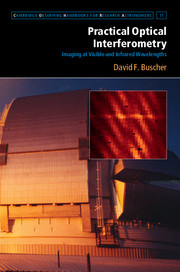Book contents
- Frontmatter
- Contents
- Principal symbols, functions and operators
- List of abbreviations
- Foreword
- Preface
- 1 Making fringes
- 2 Basic imaging
- 3 Atmospheric seeing and its amelioration
- 4 Interferometers in practice
- 5 Measurement noise
- 6 Interferometric observation of faint objects
- 7 Observation planning
- 8 Data reduction
- 9 Model fitting and image reconstruction
- Appendix A Fourier transforms
- Appendix B Supplementary online material
- References
- Index
7 - Observation planning
Published online by Cambridge University Press: 05 August 2015
- Frontmatter
- Contents
- Principal symbols, functions and operators
- List of abbreviations
- Foreword
- Preface
- 1 Making fringes
- 2 Basic imaging
- 3 Atmospheric seeing and its amelioration
- 4 Interferometers in practice
- 5 Measurement noise
- 6 Interferometric observation of faint objects
- 7 Observation planning
- 8 Data reduction
- 9 Model fitting and image reconstruction
- Appendix A Fourier transforms
- Appendix B Supplementary online material
- References
- Index
Summary
Interferometric observations need to be planned in advance, because observing time on an interferometer is a scarce resource. This planning is often carried out in the context of a competitive proposal scheme like that operated by most research telescopes. The typical process involved is that potential observers submit proposals to a ‘time-allocation committee’ or similar body, this body ranks the proposals and the most highly ranked proposals are given time.
The criteria for ranking the proposals can be somewhat subjective, but usually involve a combination of the technical feasibility of the proposed observations and the likely scientific value of the information that will result from them. In order to be highly ranked, proposals must address both of these aspects, so developing such a proposal requires expertise in two areas: familiarity with a relevant science field to understand where the gaps in knowledge are and an understanding of the ways in which different kinds of interferometric observation can provide critical information to fill these gaps.
This chapter looks at the interaction between the scientific and technical aspects of an interferometric observing proposal, with the aim of highlighting the most important areas to consider. The details of writing a competitive astronomy proposal are beyond the scope of this book, but an online search for ‘how to write an observing proposal’ turns up many useful links on the topic.
Example proposal
The material in this chapter will be illustrated in part through an example proposal for the VLTI, which was awarded observing time in August and September 2012. The science background to the proposal is that of Mira variables, named after the prototype star of the class otherwise known as Omicron Ceti. The name Mira is latin for ‘wonderful’ or ‘astonishing’, a reference to its regular appearance and disappearance from the visible sky; pulsations in the star cause large changes in brightness on periods of a few hundred days.
- Type
- Chapter
- Information
- Practical Optical InterferometryImaging at Visible and Infrared Wavelengths, pp. 180 - 193Publisher: Cambridge University PressPrint publication year: 2015



